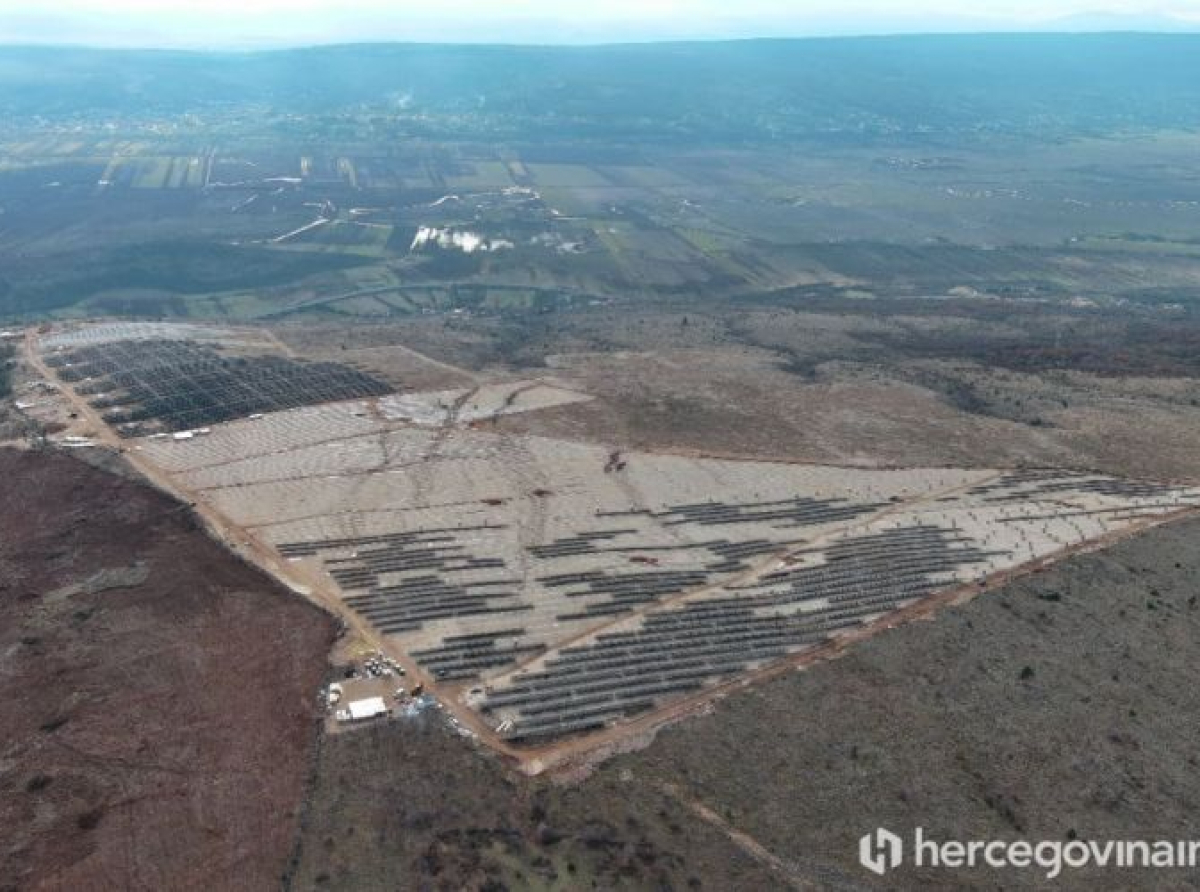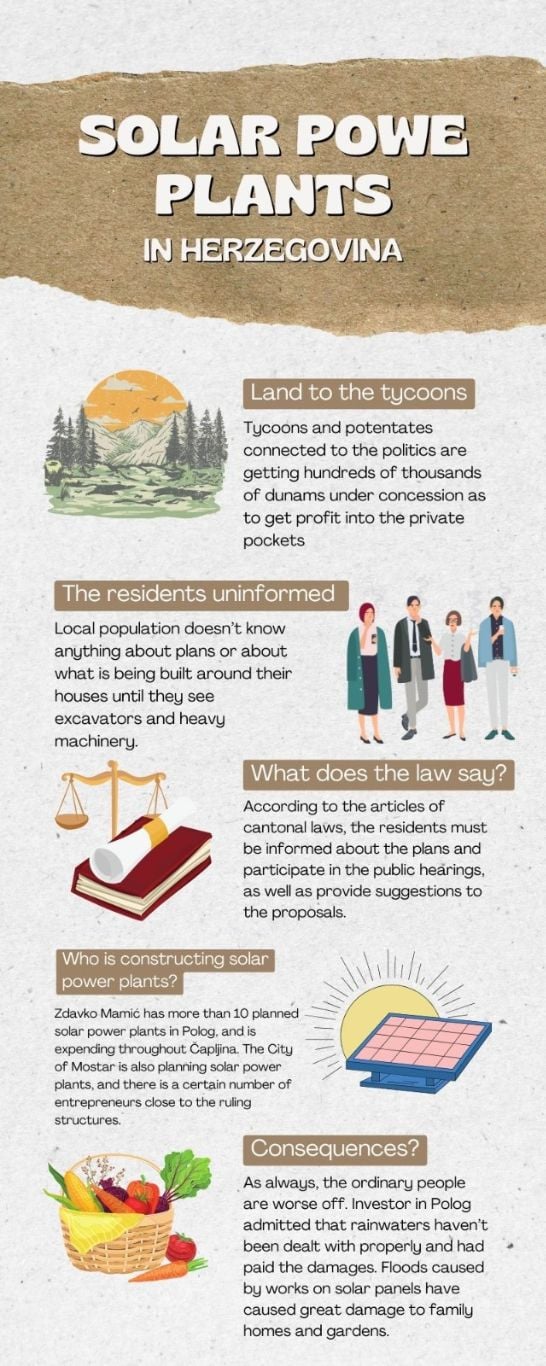Take a look at the solar farms, which become known to the locals only when they see excavators around their houses

In recent years solar farms have taken over the primacy of what the immortelle should have been, but unlike the immortelle, the procedures for obtaining permits and approvals are reserved for tycoons and potentates whose process around solar power plants is shrouded in secrecy, and this is further supported by the fact that not even the locals know what will be above and around their houses until they see the excavators leveling the land.
Citizens do not know anything about the tycoons’ plans
The Law on the Principles of Local Self-Government in the Federation of Bosnia and Herzegovina is explicit on this issue, especially in articles 25 and 29. A total of 7 groups of citizens (Gubavica, Pijesci, Međine, Prigrađani, Planinica, Miljkovići and Kozice) in Mostar alone are currently fighting against solar panels near their homes which disturb their ecosystem since many of them are engaged in animal husbandry and agriculture. This does not prevent the local authorities from working side by side with the potentates on what they call “green transition” or “investments', regardless of the fact that a cleared forest prepared for terrain leveling is the only greenery, and the only financial gain from the investment has the investor and eventually one employed security guard.
Famous articles 25 and 29
Locals have been warning for years now that everything is being done without their will, but also without their knowledge. This topic has not been the subject of any public hearing in the local communities of the area where the solar power plants should be. The law clearly mandates that citizens in the local community, through local community bodies, decide on matters important for life and work on the territory of the local community, and in particular, initiate and participate in public hearings during preparation and adoption of urban development plans on the territory of the local community, launch initiatives, give opinions and participate in the construction of utility facilities and common use facilities.
In addition to that article, the law also states that local community bodies must be consulted on issues that are decided by a two-thirds majority of the local self-government unit’s council and in the process of adopting plans of the local self-government unit, as well as on other issues on which consultation has been requested from the council or the mayor.
Gubavice site, southern part of Mostar
Residents of this area said to Hercegovina.info that, in addition to non-transparent actions, the Law on the Temporary Prohibition of the Disposal of State Property, which was passed by the High Representative in 2005, has been repeatedly violated for years. Land-use change from forest or agricultural land to construction land is a serious violation of this law.
“According to this plan state land above class 6 is given in other urban areas, and it is actually a rocky area without vegetation. In the settlements of Gubavica and Pijesca, agricultural land below class 4 is given for concessions by this plan and it is 1000 dunams of state and 10 thousand dunams of private agricultural land. With what intention was the law on agricultural land, which expressly forbids the conversion of class 1 to 4 agricultural land into construction land, grossly violated only in our villages? Particularly to such a great extent. Although Pijesca and Gubavica are located in another agricultural zone where construction is prohibited, the City of Mostar has earmarked more than 50% of the area of these settlements for the construction of solar and wind power plants. The realization of such a plan would cover more than 11 thousand dunams of agricultural land, which would leave the locals without living space, and the settlements would be turned into power plants. All this would inevitably lead to the fast disappearance of these returnees' settlements”, said Enes Rahimić warning about the work of state, cantonal and city prosecutors, who have responsibility when everyone knows that state land was sold for a pittance, and it should not have been allowed at all.
The spatial plan from 1990 was the only valid one for many areas, and everything passed after that is illegal. According to locals and experts, the stamps were “put up” without feasibility studies ever being conducted. The real question is why concessions were issued for unprofessional and illegal plans. Negligence, ignorance or deliberate omissions were best felt by the residents of Polog, i.e. the village of Međine in the Polog local community.
Polog
“On the terrain above the settlement of Polog - Donji istok, we have observed ecocide on an enormous scale, manifested through the clearing of the pine forest (which we once planted in order to have green areas), burning of the forest as well as burning of other types of waste, the irreversible clearing and leveling of the terrain, the destruction of natural water sources (in such a way that springs are buried and roads are built over them), burying of broken solar panels, burning of different types of waste. All these works were done due to the preparation of the ground for the construction of a solar power plant, although the study that was done at the Energy Institute Hrvoje Požar Zagreb (commissioned by the Institute for Spatial Planning of the City of Mostar) clearly states that this kind of power plant cannot be built on the mentioned location since the it does not meet the criteria due to the natural slope towards the settlements. Now, in practice, we have a case of leveled terrain, down which large amounts of rainwater flow directly into the settlement, carrying everything before it. We have witnessed floods that have already hit us on a couple of occasions. The question arises, what kind of green energy the city of Mostar is building?” said Armin Dubljević for hercegovina.info.
The initial selection of locations has in the earlier analysis singled out seven macrolocations of “larger” solar power plants, which represents a relatively large number of locations in relation to the total area of the City of Mostar. All initially selected locations met the criteria from the point of view of environmental protection, and based on them it was not possible to eliminate the exact location. For this reason, the location SE6 - Polog - Donji - istok was eliminated from further analysis and evaluation due to the configuration of the terrain, i.e. located on sloping terrain in the South-southwest direction.
However that didn’t stop the local and cantonal authorities from pretending to be blind before the onslaught of investors or humoring them in their plans. In addition to those two instances, the Federation government led by Nermin Nikšić has recently also given approvals for this area, but admittedly only for the company “Pozitron”, which is the least controversial in the Polog's solar megalomania.
“The Government of the Federation of Bosnia and Herzegovina adopted information and gave preliminary approvals to the Federation Ministry of Energy, Mining and Industry in the process of issuing an energy license to the company Pozitron d.o.o. Mostar for the construction of photovoltaic power plants “Liwno 1”, “Liwno 2”, “Liwno 3”, “Liwno 4”, “Liwno 5” and “Liwno 6”, installed nominal power 4.5 MW, approved connection power 4.5 MW, planned annual electricity production of 8,221 GWh, which is planned to be built at the Polog location,” said the FBiH Government after the recently held session.
Who is building solar power plants above Polog?
The already mentioned “Pozitron” is one of the investors who got an environmental permit in 2022 from the Ministry of Trade, Tourism and Environmental Protection of Herzegovina-Neretva Canton. They have a solution for 8 photovoltaic power plants. The company “Solar Lena” plans to build 4, while the already recognizable “Plavo sunce” of Zdravko Mamić, which is registered in Čitluk, is already building 10 solar power plants.
“Pozitron” from Mostar has in 2023 again got permits for the aforementioned photovoltaic power plants “Liwno”, and this year the City of Mostar, which plans to build a solar farm through its public city company “Komunalno”, also got permits, and they would like to have 10 photovoltaic power plants on Polog called “MO solar”. “Globalis” from Mostar wants 4 power plants, and the company “IM sunce” from Čitluk, also connected to Zdravko Mamić, got an environmental permit for as many as 13 photovoltaic power plants in the area that has been determined as inappropriate for the construction by the commission a long time ago.
It seems that the new Government of Herzegovina-Neretva Canton is continuing the well-established practice of former Prime Minister Nevenko Herceg when it comes to solar panels. The adoption of the cantonal spatial plan was requested at the session of the Herzegovina-Neretva Canton Assembly in November 2023, but this is the reverse order of what it should be. Herzegovina-Neretva Canton puts itself in a situation where, with this move, it legalizes everything that the local community (city or municipality) has done illegally.
The residents of Miljković and Kozica are unanimous
An investment of 300 million marks is planned in these settlements, and solar panels are coming to their doorsteps, without them being asked about anything. The local population of Kozice does not have a water supply system in 21st century, most of them are engaged in animal husbandry, and the authorities are taking the last piece of bread out of their mouths with this action, since the solar investment will flatten the hill and destroy every form of life. A solar power plant with a capacity of 75 MW is planned right next to the houses.
“The City Council had in 2012 illegally marked out stamps for solar and wind power plants on 90% of the area of our local community, which includes the entire village of Kozice, together with family houses. Despite the resulting changes that have seriously jeopardized our lives, the city authorities did not conduct a public hearing in the local community to involve the local population, which was also a legal obligation. The only public hearing for the entire spatial plan was held in the City Hall of Mostar, where none of the residents were present. The new government led by Mayor Mario Kordić is no better than the old one and it had changed the spatial plan twice in 2022, while holding only one public hearing and it was again held in the city hall. By the way, we, the residents, first learned about plans to build a plant near our homes after the Government of Herzegovina-Neretva Canton announced the concessions granted to investors”, said for hercegovina.info Mario Ćosić, representative of the group of citizens from the settlements of Miljkovići and Kozica.
They also filed a lawsuit against the Federation Ministry of Spatial Planning. The previously mentioned activists and some of our interlocutors, i.e. all the residents of seven settlements of the City of Mostar unanimously say that they are not against investments, but they believe that at the moment the allocation of land for the construction of energy facilities is being done uncontrollably based on planning documents that are 11 years old and without real insight into the actual situation on the ground, which has been significantly changed by the return of people to their pre-war residences, and they call on the local and cantonal authorities to protect the interests of citizens and to make changes to the Spatial Plan, which will relocate the existing facilities to locations as far as possible from the populated areas.


